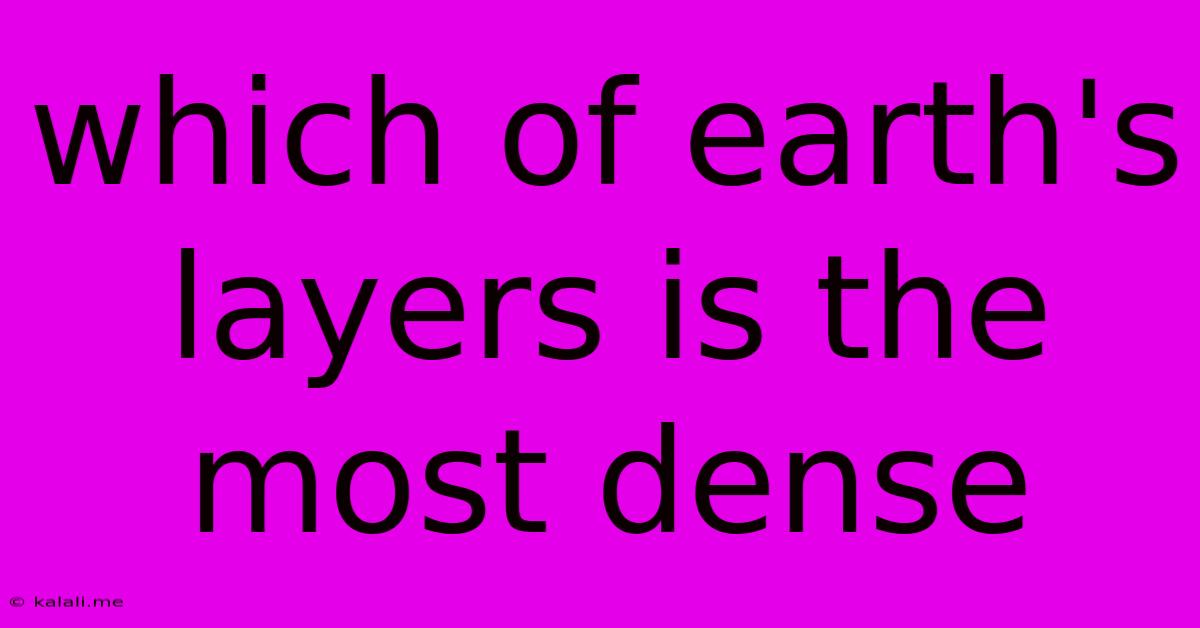Which Of Earth's Layers Is The Most Dense
Kalali
May 10, 2025 · 3 min read

Table of Contents
Which of Earth's Layers is the Most Dense? A Deep Dive into Planetary Structure
The Earth, our home, is far more than just the surface we walk on. It's a complex system of layers, each with its own unique properties, including density. Understanding these layers and their densities is crucial to comprehending Earth's formation, geological processes, and overall structure. So, which layer boasts the highest density? Let's explore!
This article will delve into the density of each of Earth's major layers: the crust, mantle, outer core, and inner core. We'll uncover which one is the densest and explore the reasons behind these density variations. We'll also touch upon the methods used to determine these densities and the implications of this knowledge for our understanding of the planet.
Earth's Layers: A Quick Overview
Before diving into density comparisons, let's briefly review Earth's primary layers:
-
Crust: The outermost solid shell, relatively thin compared to other layers. It's composed primarily of silicate rocks and is divided into oceanic crust (denser, basaltic) and continental crust (less dense, granitic).
-
Mantle: A thick layer primarily composed of silicate rocks rich in iron and magnesium. The mantle's density increases with depth due to increasing pressure. It's divided into the upper mantle and lower mantle.
-
Outer Core: A liquid layer primarily composed of iron and nickel. The extreme temperatures and pressures in the outer core allow for liquid metal flow, generating Earth's magnetic field.
-
Inner Core: A solid sphere composed mainly of iron and nickel. Despite the incredibly high temperature, the immense pressure at the Earth's center forces the iron and nickel atoms into a tightly packed solid state.
Density Comparison: The Winner is...
While the exact densities vary depending on the specific composition and depth within each layer, the inner core is by far the densest layer of the Earth. Its density is approximately 13 g/cm³. This is significantly higher than the densities of the other layers:
- Mantle: Density ranges from approximately 3.3 g/cm³ to 5.7 g/cm³.
- Outer Core: Density ranges from approximately 9.9 g/cm³ to 12.2 g/cm³.
- Crust: Density ranges from approximately 2.2 g/cm³ to 3.0 g/cm³.
Why is the Inner Core So Dense?
The extreme density of the inner core is primarily due to two factors:
-
Composition: The inner core is predominantly composed of iron and nickel, which are inherently dense elements.
-
Pressure: The immense pressure at the Earth's center forces the iron and nickel atoms to pack together incredibly tightly, resulting in a much higher density than in the other layers.
Methods for Determining Density
Scientists use various methods to estimate the density of Earth's layers. These include:
- Seismic wave studies: Analyzing how seismic waves travel through the Earth provides information about the density and composition of different layers.
- Gravitational measurements: Precise measurements of Earth's gravitational field can be used to infer density variations within the planet.
- Laboratory experiments: High-pressure experiments on materials believed to be present in Earth's interior can help determine their densities under extreme conditions.
The Significance of Density Differences
The differences in density between Earth's layers are fundamental to several key geological processes, including:
- Plate tectonics: Density differences drive the movement of tectonic plates.
- Mantle convection: Density variations in the mantle cause convection currents, which play a role in volcanic activity and mountain building.
- Magnetic field generation: The density and movement of the liquid outer core are crucial for generating Earth's magnetic field, which protects us from harmful solar radiation.
In conclusion, while each layer of the Earth possesses unique characteristics, the inner core reigns supreme in density, a testament to the extreme pressure and composition at the planet's very heart. Understanding these density variations is crucial for a comprehensive understanding of our planet’s dynamic and complex interior.
Latest Posts
Latest Posts
-
How Many Positions Are There In Sex
Jul 02, 2025
-
How Many Minutes Are In 10 Miles
Jul 02, 2025
-
How Many Milliseconds Are In A Day
Jul 02, 2025
-
If Your 16 What Year Were You Born
Jul 02, 2025
-
Ten Thousand 2 Hundrad And 14 How To Writew Numercally
Jul 02, 2025
Related Post
Thank you for visiting our website which covers about Which Of Earth's Layers Is The Most Dense . We hope the information provided has been useful to you. Feel free to contact us if you have any questions or need further assistance. See you next time and don't miss to bookmark.